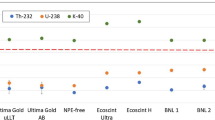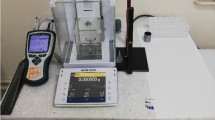Abstract
Intrinsic \(^{40}\)K radioactive backgrounds from impurities of natural K in liquid scintillation cocktails have previously been demonstrated to limit their use in ultra-sensitive applications. This work explores two methodologies in parallel for the reduction of \(^{40}\)K backgrounds in the cocktails, and lays the groundwork for use in ultra-sensitive applications. In one method, alternative low-K liquid scintillation matrix constituents were identified and in the other, a simple purification method for single components and finished cocktails was developed. Both methods were verified via ICP-MS analysis. Liquid scintillation counting of selected purified cocktails demonstrated background reduction, improved stability, and enhanced performance. The best performing purified cocktail was also counted on a custom-built ultra-low background liquid scintillation counter, with results below the detector background.




Similar content being viewed by others
References
Terlikowska T, Hainos D, Cassette P, Radoszewski T (2000) Application of \(\alpha \)/\(\beta \) discrimination in liquid scintillation counting for the purity control of 99mTc medical solutions. Appl Radiat Isot 52(3):627–632. https://doi.org/10.1016/S0969-8043(99)00221-3
Kim HR, Choi GS, Park SY, Lee CW, Han MH (2010) The radioactivity of 3H in metals by a high temperature furnace and a liquid scintillation counter. In: International Conference on Radioactive Waste Management and Environmental Remediation, vol 54525, pp 491–496. https://doi.org/10.1115/ICEM2010-40181
Lauria D, Carvalho L, Conti C (2006) Comparison of different methods for 210Pb determination in environmental samples. Adv Liq Scintillation Spectrom LSC 2005:211–216
Hou X (2018) Liquid scintillation counting for determination of radionuclides in environmental and nuclear application. J Radioanal Nucl Chem 318(3):1597–1628. https://doi.org/10.1007/s10967-018-6258-6
Boireau G, Bouvet L, Collin A, Coulloux G, Cribier M, Deschamp H, Durand V, Fechner M, Fischer V, Gaffiot J (2016) Online monitoring of the Osiris reactor with the Nucifer neutrino detector. Phys Rev D 93(11):112006. https://doi.org/10.1103/PhysRevD.93.112006
Erchinger JL, Orrell JL, Aalseth CE, Bernacki BE, Douglas M, Fuller ES, Keillor ME, Marianno CM, Morley SM, Mullen CA (2017) Background characterization of an ultra-low background liquid scintillation counter. Appl Radiat Isot 126:168–170. https://doi.org/10.1016/j.apradiso.2017.01.032
di Vacri M, Back H, Bliss M, Bronikowski M, Edwards E, Hackett B, Hoppe E, Lyons S, Rocco N (2022) Identification of background limitations to ultra-sensitive LSC counting through ICP-MS assay of LSC cocktails. J Radioanal Nucl Chem. https://doi.org/10.1007/s10967-022-08591-9
Aalseth CE, Day AR, Fuller ES, Hoppe EW, Keillor ME, LeFerriere B, Mace EK, Merriman J, Myers AW, Overman CT (2013) A new shallow underground gas-proportional counting lab-first results and Ar-37 sensitivity. Appl Radiat Isot 81:151–155. https://doi.org/10.1016/j.apradiso.2013.03.050
Seifert A, Aalseth CE, Day AR, Fuller ES, Hoppe EW, Keillor ME, Mace EK, Overman CT, Warren GA (2013) The design, construction, and initial characterization of an ultra-low-background gas-proportional counting system. J Radioanal Nucl Chem 296:915–921. https://doi.org/10.1007/s10967-012-2059-5
Erchinger JL, Aalseth CE, Bernacki BE, Douglas M, Fuller ES, Keillor ME, Morley SM, Mullen CA, Orrell JL, Panisko ME, Warren GA, Williams RO, Wright ME (2015) Development of a low background liquid scintillation counter for a shallow underground laboratory. Appl Radiat Isot 105:209–218. https://doi.org/10.1016/j.apradiso.2015.08.027
Aalseth CE, Bonicalzi R, Cantaloub MG, Day AR, Erikson LE, Fast J, Forrester JB, Fuller ES, Glasgow BD, Greenwood LR (2012) A shallow underground laboratory for low-background radiation measurements and materials development. Rev Sci Instrum 83(11):113503. https://doi.org/10.1063/1.4761923
Dow: Product safety assessment: Dow nonylphenol ethoxylate surfactants. Technical report, The Dow Chemical Company (2010)
Arnquist IJ, Beck C, di Vacri ML, Harouaka K, Saldanha R (2020) Ultra-low radioactivity Kapton and copper-Kapton laminates. Nucl Instrum Methods Phys Res, Sect A 959:163573. https://doi.org/10.1016/j.nima.2020.163573
Arnquist IJ, di Vacri ML, Rocco N, Saldanha R, Schlieder T, Patel R, Patil J, Perez M, Uka H (2023) Ultra-low radioactivity flexible printed cables. arXiv preprint arXiv:2303.10862. https://doi.org/10.48550/arXiv.2303.10862
Arnquist IJ, di Vacri ML, Rocco N, French A. Method for purification and removal of potassium from nonpolar and surfactant solutions and mixtures. PCT/US2022/045290; WO/2023/055975. https://patentscope.wipo.int/search/en/detail.jsf?docId=WO2023055975 &_cid=P12-LKTUEM-60611-1
Vasile M, Loots H, Vercammen L, Bruggeman M, Verrezen F (2022) A study for the selection of NPE-free cocktails for LSC routine measurements. J Radioanal Nucl Chem 331(8):3349–3357. https://doi.org/10.1007/s10967-022-08405-y
Varlam C, Vagner I, Faurescu D (2019) Performance of nonylphenol-ethoxylates-free liquid scintillation cocktail for tritium determination in aqueous samples. J Radioanal Nucl Chem 322(2):585–595. https://doi.org/10.1007/s10967-019-06702-7
Currie LA (1968) Limits for qualitative detection and quantitative determination. Application to radiochemistry. Anal Chem 40(3):586–593. https://doi.org/10.1021/ac60259a007
Jakonić I, Todorović N, Nikolov J, Bronić IK, Tenjović B, Vesković M (2014) Optimization of low-level LS counter Quantulus 1220 for tritium determination in water samples. Radiat Phys Chem 98:69–76. https://doi.org/10.1016/j.radphyschem.2014.01.012
Verrezen F, Loots H, Hurtgen C (2008) A performance comparison of nine selected liquid scintillation cocktails. Appl Radiat Isot 66(6–7):1038–1042. https://doi.org/10.1016/j.apradiso.2008.02.050
Zhilin C, Shixiong X, Heyi W, Yinhang Z (2010) The effect of vial type and cocktail quantity on tritium measurement in LSC. Appl Radiat Isot 68(9):1855–1858. https://doi.org/10.1016/j.apradiso.2010.04.015
Sanchez-Cabeza J, Pujol JM, Luis Leon JM, Vidal-Quadras A, Mitchell P (1993) Optimization and calibration of a low-background liquid scintillation counter for the simultaneous determination of alpha and beta emitters in aqueous samples. Radiocarbon 3:43–50
Acknowledgements
Pacific Northwest National Laboratory (PNNL) is operated by Battelle for the United States Department of Energy (DOE) under Contract no. DE-AC05-76RL01830. This work was funded by National Nuclear Security Administration (NNSA) Office of Defense Nuclear Nonproliferation Research and Development. The authors would like to thank Abdul Ibrahim at National Diagnostics, Shaun Smyth, James Thomson, and Vikki Binns from Meridian Biotechnologies, and Betsy Moran from PerkinElmer for providing samples, and for useful discussions.
Author information
Authors and Affiliations
Corresponding author
Ethics declarations
Conflict of interest
The authors declare no conflict of interest
Additional information
Publisher's Note
Springer Nature remains neutral with regard to jurisdictional claims in published maps and institutional affiliations.
Rights and permissions
About this article
Cite this article
Rocco, N.D., Arnquist, I.J., Back, H.O. et al. Impact of lowering potassium contamination in liquid scintillation cocktails for ultra-sensitive radiation detection. J Radioanal Nucl Chem 332, 4223–4229 (2023). https://doi.org/10.1007/s10967-023-09105-x
Received:
Accepted:
Published:
Issue Date:
DOI: https://doi.org/10.1007/s10967-023-09105-x




